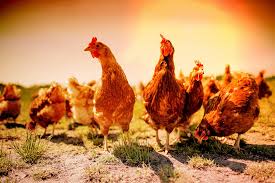🛑 How to Reduce the Effect of Heat Stress in Poultry
Chickens are very vulnerable and at risk of overheating due to heat stress in hot and humid weather. Chickens have no sweat glands and have to pant to get rid of body heat by other means. Chickens often raise their wings to radiate heat from poorly feathered areas. This requires more energy from the chicken than just sweating. Eventually, without relief from the heat, chickens will often become exhausted from heat exhaustion and heat stress. When chickens pant excessively, it increases their respiratory rate, which in turn affects egg laying, growth rates or even lead to higher mortality.
Read also: 10 reasons why my chickens may be sneezing
What is Heat Stress?
Chickens are very sensitive to high temperatures and their ability to lose body heat is limited by their plumage, high metabolic activity and the absence of sweat glands. Heat stress usually occurs when chickens are exposed to high ambient temperatures and in combination with low air velocity and high relative humidity.
It is the environmental temperature in combination with the humidity level that determines the level of heat stress. See the image below, which shows that a humidity level between 45 and 75 % in combination with a temperature below 30 °C is comfortable for chickens.
 Learn More
Learn MoreHow do chickens respond to increasing temperatures?
Chickens will try to re-establish their heat balance with the surrounding by changing their normal behaviour.

Support and Relief Measures for Chickens under Heat Stress
Heat stress in chickens can have serious consequences on profit, performance, and production. Various measures can be taken to reduce heat stress in poultry.
Management
Adjust management practices correctly, such as ventilation, stocking density, litter management and more. Design and orientate the farm house to reduce heat stress as much as possible. Insulate the house structure sufficiently to prevent solar heat gain.
Stocking density
One of the best ways to prevent heat stress is to avoid overcrowding. To decrease heat immediately, decrease the number of chickens in the house.
Avoid unnecessary activity. The summer heat is stressful enough for the chickens. Make sure you do not disturb the chickens during the hottest time of the day.
Provide ventilation
Often the heat in the house can be controlled by the airflow. Airflow at chickens level helps to dissipate the heat from the chickens. It is therefore important to increase ventilation to dissipate the heat from the chickens. However, there may be certain situations where ventilation is limited.
Naturally ventilated houses are at risk of heat stress if the air is calm and there are no other fans. Mechanically ventilated houses can also be at risk if the ventilation capacity and air mix are not suitable for the size and number of chickens present.
Feeding
Chickens are usually hungriest in the morning and tend to stuff themselves. However, they the become more susceptible to heat stress in the afternoon. A solution may be to withdraw the feed six hours before the afternoon peak, thus reducing the risk of heat stress.
The feed can be reintroduced after the peak temperatures have gone down. The chickens can then eat during the night when cooler temperatures are expected. When lowering the feed line, it is important that the feeders are already full. The lights can be used during the night-time (midnight) to get the chickens to eat.
Depending on how often this feeding method is used, some loss in body weight may be noticed. So only follow this feed method when heat stress temperatures are expected.
Water management
During heat stress, chickens will increase their water intake by 2 to 4 times. Adequate water space, well-functioning waterers and cool water temperatures will encourage the chickens to drink. Provide sufficient fresh and cool drinking water regularly (around 20°C is ideal). Protect drinking water from direct sunlight to keep it cool: use a roof over the tank and paint the tanks white to get cool drinking water.
Using electrolytes
An option to reduce heat stress is to add electrolytes to the flock’s drinking water for up to three days. Loss of several minerals including potassium, sodium, phosphorus, magnesium and zinc, is caused by heat stress. To increase water intake, electrolytes can be used. Provide electrolytes prior to the heat stress period.
Read also: 15 ways to delegate successfully in your poultry farming business
Providing sodium bicarbonate
For laying hens, the use of sodium bicarbonate in the feed or the use of carbonated water is useful. The acid-balance can be altered in poultry by panting and the release of carbon dioxide due to heat stress. In addition, the available bicarbonate, which is important for eggshell formation, may be altered. By reducing this changes, sodium bicarbonate can be used.
Supplementing drinking water with vitamins (A, D, E and B complex) can be effective at tackling heat stress mortality in broilers. In breeding poultry, vitamin C can effectively moderate the decrease in egg production and eggshell quality in laying hens caused by hot temperatures.
For more information and updates join our WhatsApp group HERE
Like our page on Facebook HERE











